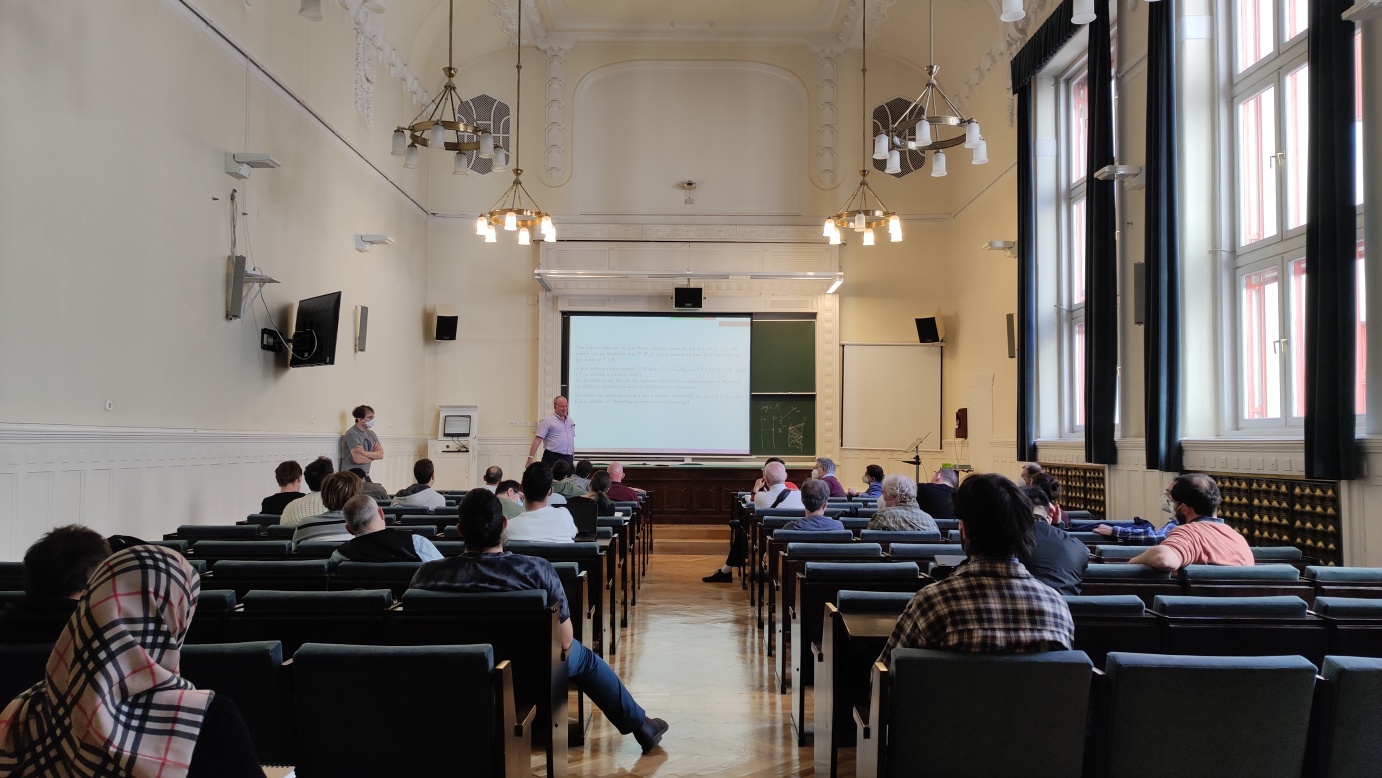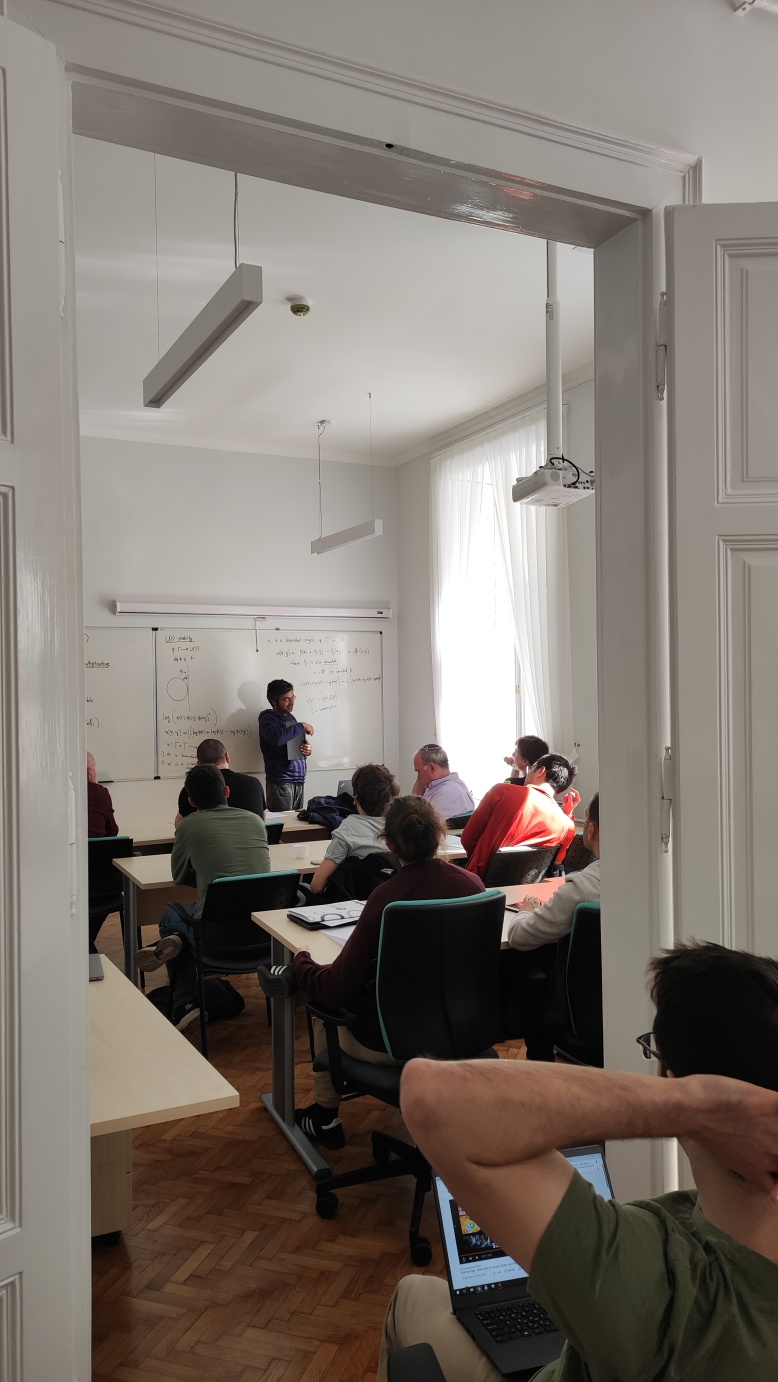Workshop: Geometric Aspects of Flexible Stability
Description
The flexible stability is a relatively new notion of rigidity for countable sofic groups. Roughly speaking, a sofic group is flexibly stable if all its sofic approximations are constructed by taking unions of finite Schreier graphs and adding a little bit of noise. The subject of the workshop will be centered around the following question: Suppose G is a fundamental group of a Riemannian manifold M. How can we use the geometry of M to study the flexible stability of G?
Each participant is encouraged to give a lecture on a topic of his/her choice. We plan to devote at least half of the workshop to discussions and joint research.
- Oren Becker
- Michael Chapman
- Alon Dogon
- Mikael de la Salle
- Mikolaj Fraczyk
- Maria Gerasimova
- Lukas Gohla
- Lukasz Grabowski
- Izhar Oppenheim
- Arie Levit
- Alex Lubotzky
- Bharatram Rangarajan
- Héctor Jardón Sánchez
- Raz Slutsky
- Itamar Vigdorovich
Schedule
Monday 21.03
10:00–11:00 Arie Levit Surface groups are flexibly stable
11:10–12:10 Mikolaj Fraczyk On certain branched covers of higher rank locally symmetric spaces
12:10–14:10 Lunch break
14:10-15:10 Mikael de la Salle Spectral gap and Hilbert-Schmidt (flexible) stability
15:40-∞ discussion time
Tuesday 22.03
10:00–11:00 Michael Chapman Efficient stability for finite groups
11:10–12:10 Lukasz Grabowski Stability with respect to the rank metric
12:10-∞ free time
Wednesday 23.03
10:00–11:00 Raz Slutsky The space of traces of the free group and other free products
11:30–12:30 Itamar Vigdorovich Studying HS-stability through characters and dynamics
12:30–14:10 Lunch Break
14:10–15:10 Alon Dogon Flexible HS-stability, projective representations and Connes-embeddable groups
15:40–∞ discussion time
Thursday 24.03
10:00–11:00 Alex Lubotzky Good locally testable codes
11:10–12:10 Bharatram Rangarajan Cohomological Techniques in Uniform Stability
12:10–14:10 Lunch Break
14:10–15:10 Izhar Oppenheim Local criteria for vanishing of Banach cohomology
15:40–∞ discussion time
Friday 25.03
10:00–11:00 Lukas Gohla TBA
11:10–12:10 Oren Becker Testability of relations between permutations
12:10–∞
Abstracts
Oren Becker Testability of relations between permutations
Let \(A\) and \(B\) be permutations in \(S_n\), such that either (*) \(AB=BA\), or (**) the pair \((A,B)\) is far from every pair of permutations \((A',B')\) satisfying \(A'B'=B'A'\). Is there a probabilistic algorithm that distinguishes, with high probability of success, between Case (*) and Case (**) by reading only \(k\) entries of \(A\) and \(B\), for \(k\) independent of \(n\)? In other words, is the equation \(XY=YX\) testable in permutations? What about other equations, such as \(XY^2=Y^2 X\) or \(XY^2=Y^3 X\)? What about simultaneous systems of equations? Problems of this sort belong to the field of Property Testing. I will explain the connection to stability, and introduce a relaxation of stability, called Benjamini-Schramm rigidity, and its applications to the algorithmic problem described above. Based on joint work with Alex Lubotzky and Jonathan Mosheiff.
Michael Chapman Efficient stability for finite groups
We define quantitative notions of stability for finite groups and relate them to property testing algorithms. We then discuss some results in this direction and possible applications of such results for group hardness of approximation.
Michael de la Salle Spectral gap and Hilbert-Schmidt (flexible) stability
I will explain a very simple idea to use spectral gap estimates for questions of stability in normalized Hilbert-Schmidt norm. In its most elementary form, this idea allows us to prove that the direct product of two (flexibly) stable groups is again (flexibly) stable, provided that one of the groups has Kazhdan's property (T). This property (T) assumption is necessary, as Adrian Ioana has proved that the direct product of two non-abelian free groups is not stable. This idea is also applicable for finite groups, and this allow to greatly simplify some of the stability results that have been proved by Ji-Natarajan-Vidick-Yuen-Wright in their announced resolution of the Connes embedding problem.
Alon Dogon Flexible HS-stability, projective representations and Connes-embeddable groups
Flexible HS-stability is a rigidity property for sequences of approximate unitary representations of a group, asking that all such are close to sequences of compressions of genuine representations (w.r.t. the Hilbert Schmidt norm). Recently, in the work of Ioana, Spaas and Wiersma, a novel way of refuting this property was discovered. The method is based on (relative) property (T) being an obstruction to having certain non-trivial approximately multiplicative projective unitary representations. We will present their work, using \({\rm SL}_2(\mathbb Z)\) semidirect product \(\mathbb Z^2\) as an example. We will comment on ongoing work of the author, which utilizes this method to show flexible HS-stability implies the existence of non Connes-embeddable groups in certain situations.
Mikolaj Fraczyk On certain branched covers of higher rank locally symmetric spaces
A finitely generated group \(\Gamma\) is flexibly stable if all its sofic approximations are, up to a small modification, disjoint unions of coset graphs of \(\Gamma\). There is a Riemannian geometric analogue of this property for a symmetric space \(X\): suppose that \(M\) is a Riemannian manifold which locally looks like \(X\) in most places. Then there exists a disjoint union \(Y\) of finite volume quotients of \(X\), such that after cutting out small subsets of \(M\) and \(Y\), they become isometric. Such a property is probably very hard to prove any higher rank symmetric space. A good place to start is the case when \(M\) is a branched cover of a locally symmetric space with very small branching locus. In my talk I will explain a work in progress, where I show that at least certain very specific constructions of cyclic branched covers of higher rank locally symmetric spaces will never yield a counter-example to flexible stability in higher rank.
Lukasz Grabowski Stability with respect to the rank metric
This talk is concerned by stability with respect to the rank metric. This topic is motivated by the stability with respect to the Hamming distance, as studied by e.g. Arzhantseva-Paunescu and Becker-Lubotzky-Thom. In the talk, I will review some parts of the work by myself and Elek about rank stability for abelian groups, and by Becker-Lubotzky-Thom on stability with respect to the Hamming distance for polycyclic groups. This will allow me to explain what are the obstacles to obtain similar results for the rank distance for polycyclic groups, and the progress towards solving them (joint work with Joan Claramunt). Those latter resutls are essentially about analogues of effective Nullstellensatz and effective ideal membership problems for the group rings of polycyclic groups.
Arie Levit Surface groups are flexibly stable
I will describe a geometric proof that surface groups are flexibly stable relying on branched covers and negative curvature. I will attempt to survey the main ideas used in the proof. This talk is based on a joint work with Nir Lazarovich and Yair Minsky.
Alex Lubotzky Good locally testable codes
An error-correcting code is locally testable (LTC) if there is a random tester that reads only a small number of bits of a given word and decides whether the word is in the code, or at least close to it. A long-standing problem asks if there exists such a code that also satisfies the golden standards of coding theory: constant rate and constant distance.
Unlike the classical situation in coding theory, random codes are not LTC, so this problem is a challenge of a new kind. We construct such codes based on what we call (Ramanujan) Left/Right Cayley square complexes. These are 2-dimensional versions of the expander codes constructed by Sipser and Spielman (1996). The main result and lecture will be self-contained. But we hope also to explain how the seminal work Howard Garland ( 1972) on the cohomology of quotients of the Bruhat-Tits buildings of p-adic Lie group has led to this construction ( even though, it is not used at the end). Based on joint work with I. Dinur, S. Evra, R. Livne, and S. Mozes
Izhar Oppenheim Local criteria for vanishing of Banach cohomology
The aim of this lecture is to introduce local criteria for vanishing of Banach cohomology for groups acting on simplicial complexes. The main idea is to generalize the machinery of Garland to Banach spaces. Such generalizations are available in two flavors depending whether the simplicial complex is colorable or not. If time (and interest) permit, we will also discuss applications for \(L^p\) fixed point spectrum of random groups.
Bharatram Rangarajan Cohomological Techniques in Uniform Stability
In an ongoing joint work with Glebsky, Lubotzky and Monod, we construct an analogue of bounded cohomology in an asymptotic setting in order to prove uniform stability of lattices in Lie groups (of rank at least two) with respect to unitary groups equipped with a metric induced by a submultiplicative norm. The main idea is the notion of "defect diminishing", which allows us to reduce stability as a homomorphism lifting problem with abelian kernel, and relates to an asymptotic bounded cohomology \(H_a^2\) whose vanishing implies uniform stability. If time permits, I shall sketch a proof of the main result: namely, the vanishing of \(H_a^2(G,V)\) for lattices in high rank Lie groups (along the lines of the proof in Burger-Monod that bounded cohomology vanishes for such groups), implying uniform stability for this class of groups.
Raz Slutsky The space of traces of the free group and other free products
After introducing the notion of traces and characters on groups and their relation to classical rigidity results, Invariant Random Subgroups (IRS) and Hilbert-Schmidt Stability, we will show that the space of traces of the free group \(F_n\) is a Poulsen simplex for every \(2 \leq n \leq \infty\), that is, the set of extreme points is dense. We will then discuss the space of traces of other free products. This is based on joint work with Joav Orovitz and Itamar Vigdorovich.
Itamar Vigdorovich Studying HS-stability through characters and dynamics
We study the relation between Hilbert-Schmidt stability of amenable groups and a certain finite approximation property of dynamical systems that are naturally associated with the group. For example, we find that HS-stability of polycyclic groups happens to be equivalent to a purely dynamical question regarding toral dynamics, and is thus related to classical dynamical conjectures; another example, is that HS-stability of wreath products \(\mathbb Z\wr \mathbb A\) boils down to standard dynamical properties of Bernoulli shifts. In this talk I'll elaborate on this connection which is based on the work of Hadwin and Shulman regarding group characters, and explain how it can be used to derive new positive and negative results in stability. The talk is based on a joint work with Arie Levit


